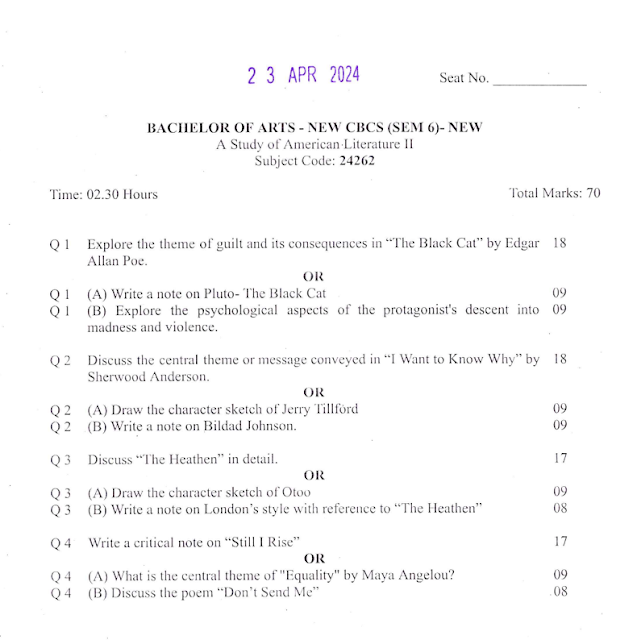Old Question Papers
Rajeshvari Rana's blog
The future belongs to those who learn more skills and combine them in creative way. -Robert Greene
Welcome to my blog.
Exam Essentials: Tips for Writing
- Roll number
- Your signature
- Date
- Subject Code
- Subject name
- Make sure to check that the supervisor's signature is on all sheets. These small steps are crucial to ensure your paper is properly recorded and evaluated.
- Read the Question Carefully
Before starting, take a moment to fully understand the question. Highlight key terms and pay attention to what the question is asking, such as "discuss," "compare," or "explain."
- Plan Your Answer
Spend a few minutes planning your response. Create a quick outline in your head or on paper. This will help you structure your answer and ensure you cover all parts of the question. A clear introduction, body, and conclusion are essential.
- Answer the Question Directly
Be clear and to the point. Avoid adding unnecessary information. Stick to the relevant points and ensure each paragraph addresses a specific aspect of the question.
- Time Management
Divide your time based on the number of questions. If you have 2 hours and 5 questions, spend around 20-25 minutes on each question. Don’t spend too much time on one question, as this may leave you with little time for the others.
- Write Clearly and Neatly
Your handwriting plays a role in how your answers are perceived. Write legibly so the examiner can easily read your work. Avoid using complicated words if they make your writing unclear.
- Structure Your Answer
- Start with a brief introduction that reflects your understanding of the question.
- Write well-organized paragraphs, each addressing a different point.
- Use headings or bullet points where necessary to make it easier for the examiner to follow your answer.
- Conclude with a summary or final thought, reinforcing your main points.
- Use Proper Punctuation:
Ensure that all punctuation marks are used correctly. For example, avoid using ":-" when writing the subject in a formal letter or essay; instead, just use a colon (e.g., "Subject: Meeting Agenda").
Always place commas, full stops, and other punctuation marks inside quotation marks if they end a sentence.
Punctuation can make or break the clarity of your writing. Some key points:
- Period (.): Use to end a complete sentence.
- Comma (,): Use to separate items in a list or after introductory words.
- Semicolon (;): Connect closely related sentences or separate items in complex lists.
- Colon (:): Use before listing items or introducing an explanation.
- Quotation Marks (" "): Use to enclose direct quotes or specific terms.
- Capitalization Rules:
Always capitalize the first word of every sentence.
Proper nouns (names of people, places, organizations) should always be capitalized.
Don’t capitalize common nouns or non-proper nouns unless they are at the beginning of a sentence.
- Correct: The report was completed on time.
- Incorrect: the report was completed on time.
- Use Formal Language:
Avoid using slang, colloquial phrases, or overly casual language. Stick to professional and academic tones.
Use words that are appropriate for the context. For example, in academic writing, avoid vague terms like "things" or "stuff" and instead be specific.
- Structure and Clarity:
Organize your ideas in a clear and logical order. Start with an introduction, followed by body paragraphs, and end with a conclusion.
Each paragraph should focus on one main idea, supported by evidence or examples.
Avoid long, convoluted sentences. Use clear, concise language to communicate your ideas.
- Proofreading:
Always proofread your paper for spelling, grammar, and punctuation errors. Don’t rely solely on spell-check software.
Pay attention to common mistakes such as subject-verb agreement and incorrect word usage (e.g., “their” vs. “there”).
- Stay Focused on the Topic:
Keep your writing aligned with the main topic or question. Avoid going off on tangents or adding unnecessary information that doesn’t contribute to your argument.
- Be Specific and Avoid Generalizations:
When presenting arguments or evidence, be specific. Instead of saying "Many people think," provide actual statistics or direct quotes from reliable sources.
- Use Examples and Diagrams
Where applicable, support your points with relevant examples or diagrams. This can help demonstrate your understanding and make your answers more robust.
- Revise Before Submitting
If time permits, go back and review your answers. Check for spelling or grammatical errors, ensure all parts of the question are addressed, and confirm that your response is clear and complete.
- Presentation Matters
A well-presented paper gives a good impression. Underline important points, leave space between answers, and number your responses clearly to make it easy for the examiner to navigate your paper.
- Stay Calm and Focused
Exams can be stressful but try to remain calm and maintain your focus. If you get stuck, move on to another question and come back to the difficult one later.







